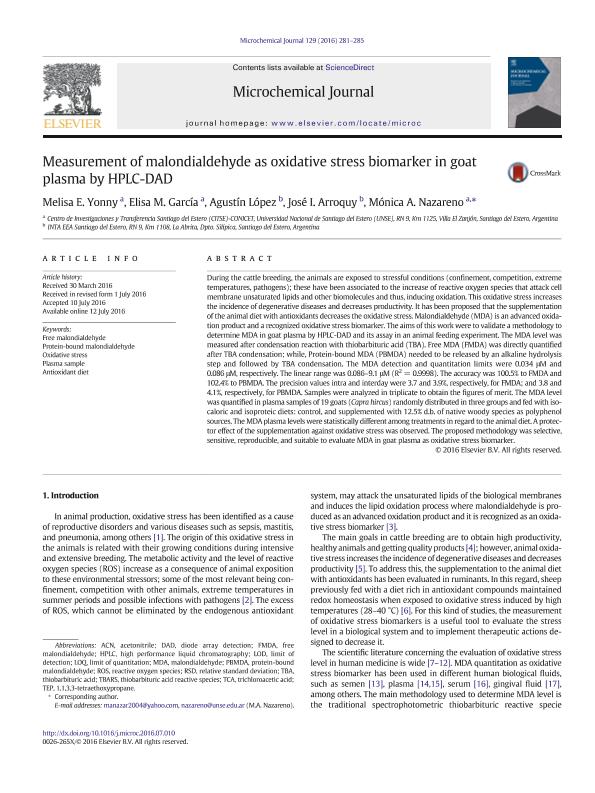Artículo
Measurement of malondialdehyde as oxidative stress biomarker in goat plasma by HPLC-DAD
Yonny, Melisa Evangelina ; García, Elisa Mariana
; García, Elisa Mariana ; Lopez, Agustin
; Lopez, Agustin ; Arroquy, Jose Ignacio
; Arroquy, Jose Ignacio ; Nazareno, Mónica Azucena
; Nazareno, Mónica Azucena
 ; García, Elisa Mariana
; García, Elisa Mariana ; Lopez, Agustin
; Lopez, Agustin ; Arroquy, Jose Ignacio
; Arroquy, Jose Ignacio ; Nazareno, Mónica Azucena
; Nazareno, Mónica Azucena
Fecha de publicación:
11/2016
Editorial:
Elsevier Science
Revista:
Microchemical Journal
ISSN:
0026-265X
Idioma:
Inglés
Tipo de recurso:
Artículo publicado
Clasificación temática:
Resumen
During the cattle breeding, the animals are exposed to stressful conditions (confinement, competition, extreme temperatures, pathogens); these have been associated to the increase of reactive oxygen species that attack cell membrane unsaturated lipids and other biomolecules and thus, inducing oxidation. This oxidative stress increases the incidence of degenerative diseases and decreases productivity. It has been proposed that the supplementation of the animal diet with antioxidants decreases the oxidative stress. Malondialdehyde (MDA) is an advanced oxidation product and a recognized oxidative stress biomarker. The aims of this work were to validate a methodology to determine MDA in goat plasma by HPLC-DAD and its assay in an animal feeding experiment. The MDA level was measured after condensation reaction with thiobarbituric acid (TBA). Free MDA (FMDA) was directly quantified after TBA condensation; while, Protein-bound MDA (PBMDA) needed to be released by an alkaline hydrolysis step and followed by TBA condensation. The MDA detection and quantitation limits were 0.034 μM and 0.086 μM, respectively. The linear range was 0.086–9.1 μM (R2 = 0.9998). The accuracy was 100.5% to FMDA and 102.4% to PBMDA. The precision values intra and interday were 3.7 and 3.9%, respectively, for FMDA; and 3.8 and 4.1%, respectively, for PBMDA. Samples were analyzed in triplicate to obtain the figures of merit. The MDA level was quantified in plasma samples of 19 goats (Capra hircus) randomly distributed in three groups and fed with isocaloric and isoproteic diets: control, and supplemented with 12.5% d.b. of native woody species as polyphenol sources. The MDA plasma levels were statistically different among treatments in regard to the animal diet. A protector effect of the supplementation against oxidative stress was observed. The proposed methodology was selective, sensitive, reproducible, and suitable to evaluate MDA in goat plasma as oxidative stress biomarker.
Archivos asociados
Licencia
Identificadores
Colecciones
Articulos(SEDE CENTRAL)
Articulos de SEDE CENTRAL
Articulos de SEDE CENTRAL
Citación
Yonny, Melisa Evangelina; García, Elisa Mariana; Lopez, Agustin; Arroquy, Jose Ignacio; Nazareno, Mónica Azucena; Measurement of malondialdehyde as oxidative stress biomarker in goat plasma by HPLC-DAD; Elsevier Science; Microchemical Journal; 129; 11-2016; 281-285
Compartir
Altmétricas



